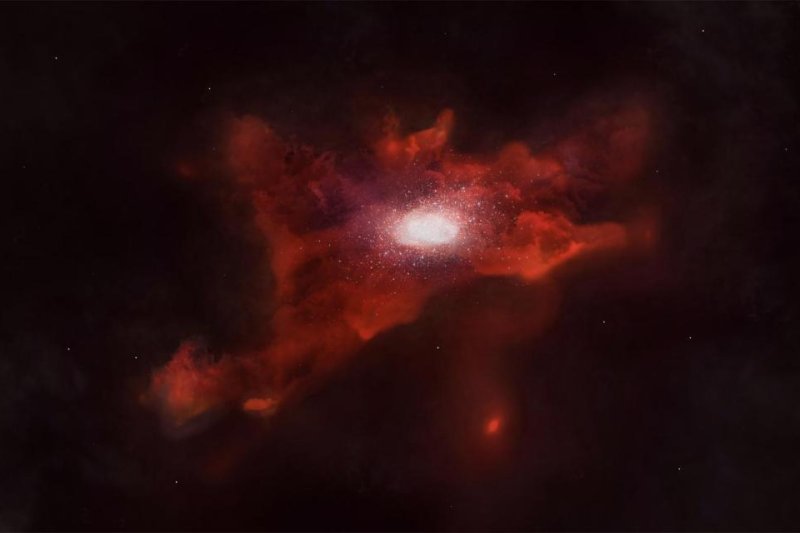An artistic rendering shows a cloud of gaseous carbon wafting beyond the young galaxy in its center. Photo by
NAOJ
Dec. 16 (UPI) -- Old -- but newly analyzed -- data from the Atacama Large Millimeter/submillimeter Array in Chile suggest young, growing galaxies are enveloped in a massive cloud of carbon gas.
Cosmological models have not previously predicted the presence of such clouds, but using ALMA observations, scientists successfully measured billows of gaseous carbon measuring 30,000 light-years across.
"We examined the ALMA Science Archive thoroughly and collected all the data that contain radio signals from carbon ions in galaxies in the early universe, only one billion years after the Big Bang," Seiji Fujimoto, an astronomer at the University of Copenhagen, said in a news release. "By combining all the data, we achieved unprecedented sensitivity. To obtain a data set of the same quality with one observation would take 20 times longer than typical ALMA observations, which is almost impossible to achieve."
For the first few hundred million years after the Big Bang, the universe consisted mostly of hydrogen. Heavier elements like carbon and oxygen didn't proliferate until stellar populations began to explode. Nuclear fusion in stars supplied the early universe with a more diverse chemical palate.
Scientists have previously found heavy elements inside faraway galaxies from the early universe, but never before have astronomers found heavy elements outside of galaxies -- in intergalactic space.
The newly identified clouds extend far beyond the edges of the galaxies that they surround.
"The gaseous carbon clouds are almost five times larger than the distribution of stars in the galaxies, as observed with the Hubble Space Telescope," said Masami Ouchi, a professor at the National Astronomical Observatory of Japan and the University of Tokyo. "We spotted diffuse but huge clouds floating in the coal-black Universe."
Fujimoto led the research while a doctoral student at the University of Tokyo. The work was published Monday in the Astrophysical Journal.
Fujimoto, Ouchi and their researcher partners estimate the carbon may have been expelled by the high-energy cosmic winds and relativistic jets generated by supermassive black holes. It's also possible carbon was pushed out of the galaxy by supernova explosions.
"Young galaxies seem to eject an amount of carbon-rich gas far exceeding our expectation," said Andrea Ferrara, a professor at Scuola Normale Superiore di Pisa.
The authors of the new study are currently using a variety of powerful telescopes to investigate the link between galactic outflows and the clouds of carbon surrounding young galaxies.















